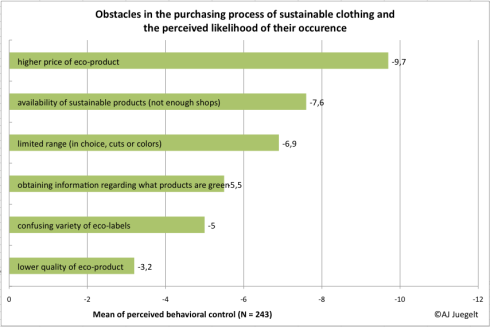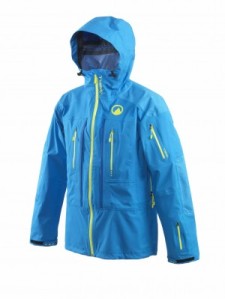You are currently browsing the tag archive for the ‘consumer behavior’ tag.
SECTION 4 – PRICE AND AVAILABILITY OF GOODS IN MORE DETAIL
Additional research results also showed that consumer access is key. Price and availability are the two main factors as we have witnessed in the previous post.
Bivariate correlations with perceived negative effects of higher prices showed that:
- older people (+.210**)
- with more income (+.167**)
- and accentuated levels of ethical obligation (+.220**),
- often in the Hiking/Climbing and the Skiing segments
are not as much negatively affected in their buying intention when expecting price premiums. Therefore, their more positive levels of perceived behavioral control in terms of price have a supportive effect on their purchase behavior of green clothing products.
This consumer type resembles a target group description that has often been called LOHAS (Life of Health and Sustainability). LOHAS are defined by Nielsen as consumers who are lifestyle-oriented, active stewards of the environment that incorporates those environmental and social values into their purchase decisions (cp. Nielsen 2009 about Canadian shoppers). But while the connection between environmental attitude, green identity and ethical obligation and eco-friendly purchasing decisions is strong, the decision still largely depends on the funds the individual consumer has at her disposal. Here, the older, the more educated means more income – more income means private budget isn’t as tight (that’s also why there is so many skiers – the correlation between skiing and age is positive, while it’s exactly the other way round for all boardsports. I must admit though – the survey has primarily been targeted at the boardsports scene and left younger freeskiers aside a little bit, which is truly a shame…). After all, this is one of the major discrepancies when trying to market green outerwear to the snowboard & freeski kids – for them it’s all about style and price, while green comes last for most of them, understandably. This is why companies from the action sports industry need to find ways to offer sustainable products without hefty price premiums. This blog and future post are trying to give some insights on potential solutions!
Bivariate correlations with expected levels of availability of eco-friendly outerwear in the stores showed that respondents with:
- accentuated levels of environmental identity (-.139*)
- positive green consumption attitudes (-.267**)
- a stronger feeling of ethical obligation to buy environmentally friendly (-.142*)
- and under the influence of significant others from the close social environment (-.133*)
were likely to show more positive purchase intentions, despite that fact that they expected availability to be lower. An explanation: the negative correlation means that the more positive the respondent’s attitude towards buying eco-friendly, the more he saw the lack of green products in the stores as a big obstacle. This lack of presence in the shop on the other hand did not influence the buying intention negatively. This means their behavioral intention to purchase green clothing was higher, although they knew about potential obstacles in the buying process (no nearby shops with a sustainable product range from multiple brands, etc.). This is good news! The finding shows that this (more extreme type of) green consumer is willing to overcome these obstacles actively. But as this results in higher search costs (time and money invested to find or identify green products), it limits the size of the potential target group. Thus, improving the distribution strategy is important. It’s key to develop synergies between industry players on all levels of the supply chain to create a stronger and larger distribution network.
These two findings add more depth to the results from the previous blog and are also an important outcome for the upcoming marketing research analysis in the following blog posts about this topic. Stay tuned for more updates this coming week!
** correlation is significant at the .01 sign. level (2-tailed).
* correlation is significant at the .05 sign. level (2-tailed).
SECTION 3 – CONTROL BELIEFS AND THE PERCEIVED LIKELIHOOD OF OCCURRENCE
Perceived behavioral control (PBC) about purchasing eco-friendly clothing stands for the problem of implementation, the missing ability to perform environmentally or socially friendly acts. The level of PBC depends on the positive perception of facilitating factors or the negative perception of obstacles and their likelihood of occurrence, no matter if the control beliefs are rational/true or not (Ajzen 1988)[1]. Perceived control over the behavior accounts for behavioral decisions that are not under complete volitional control. This means that in the context of sustainable, functional outerwear or any other type of consumer behavior regarding eco-friendly products there are several external factors, which prohibit green consumer behavior. Six key factors were used in my paper to account for the obstacles in this context. The set of questions covers some, not all, of the key marketing issues in the areas of product development, pricing, distribution and communication. They contribute to the intention-behavior gap. This gap exists because consumers with very pronounced environmental attitudes might display a strong intention to purchase eco-friendly products (see Section 1), but get obstructed by several obstacles when trying to put their intention into action.
Therefore, the following two sets of questions were asked (as in the previous blog about the effects of social influences on the development of positive or negative purchasing intentions, the results were multiplied):
Which of the following problems affect the amount of environmentally friendly outerwear that you purchase?
- higher price of eco-products
- availability (not enough shops)
- limited range (choice, cuts or colors)
- lower quality of eco-product
- confusing variety of eco-labels
- obtaining information regarding what products are environmentally friendly
‘always a problem’ (-3) to ‘never a problem’ (+3) // note: items are reverse coded
The second step was the consumer’s perceived control or ability to act:
Please indicate below whether or not you believe that these problems are likely to occur when shopping for environmentally friendly outerwear…
Very unlikely (+1) to very likely (+7)

Obstacles in the purchasing process of sustainable clothing and the perceived likelihood of their occurrence (average per item across the entire sample)

Established, big companies in the outdoor sport business want to make a move towards a sustainable future. But there are several obstacles that slow this movement down. Sourcing of quality, eco-friendly material, research & development, necessary to come up with new innovative products from recycled or renewable resources, and developing new distribution channels and context-specific messaging are only a few factors that need to be understood. By now, it has become clear to many marketing managers, that “going green” does not necessarily create higher costs on the production side, but that it’s actually possible to produce high-performance, eco-friendly products at approximately the same costs
as conventional ones. Quality is also no issue! Snowboards’ or Skis’ edges from recycled steel, impregnated wooden side walls or topsheets laminated with environmentally friendly glue and natural colors, 20.000mm recycled polyester garments in bright colors, recyclable zippers, etc. – all these product components are available in high quality at only slightly higher prices. Zimtstern’s Dominik Fuß interviewed by ISPO in 2009: “We are already able to develop reasonably priced, eco-friendly products that don’t need to cost more!
But the outdoor sports companies are still hesitant to change their entire product line to become 100% sustainable. Besides – it’s no piece of cake. While smaller and more flexible “green” start-ups can focus on profitable niche-markets, changing the production process and marketing strategy, to offer such a portfolio within only few seasons, is next to impossible for the big global players. “I think, it’s a state of mind, which needs to change in the whole company – once it’s top of mind in everybody’s head, many people come up with ideas and solutions. But this change does not happen over night.” – Maritxu Darrigrand, Head of Sustainability at Roxy.
This philosophy needs to be established within entire companies in the coming years – but this will only work, if producers and retailers can trust consumer demand. (Most often, only top of the line products, often signature series of sponsored celebrity athletes, could demonstrate that, even at slightly higher costs, they still deliver an acceptable margin through price premiums.) Consumers like to claim their willingness to pay higher prices and often see themselves as conscious consumers, while the truth is, that price and other standard product attributes still influence the purchase decisions the most. And buying behavior is also affected by social norms and perceived obstacles. One of the main hypothesis of this project is that individuals with a strong outdoor sports background (surfing, climbing, snowboarding, etc.) have a stronger connection to nature and that this connection positively influences their decisions compared to other consumers.
This research project for the Department of Service and Technology Marketing of the Technical University of Munich, Germany, has been designed to understand those effects, identify problems and find solutions. The online-survey assesses the influences on end-consumers’ purchasing behavior for environmentally friendly products in the outdoor sports segment.
Link to the survey: http://www.unipark.de/uc/eco-friendly-outdoor-products/
Thank you in advance, for participating in the study! It will take less than 20 mins. of your time and your input will help to make a difference!
The results of this study will reach the heads of sustainability, marketing managers and product developers in a lot of big, internationally operating outdoor sports companies.
Thanks to our sponsors Völkl Snowboards and O’Neill, there are some nice eco-friendly products up for grabs!!
Don’t forget to check out the 7Sky GreenRoom and inform yourself about the BlueSign label.


